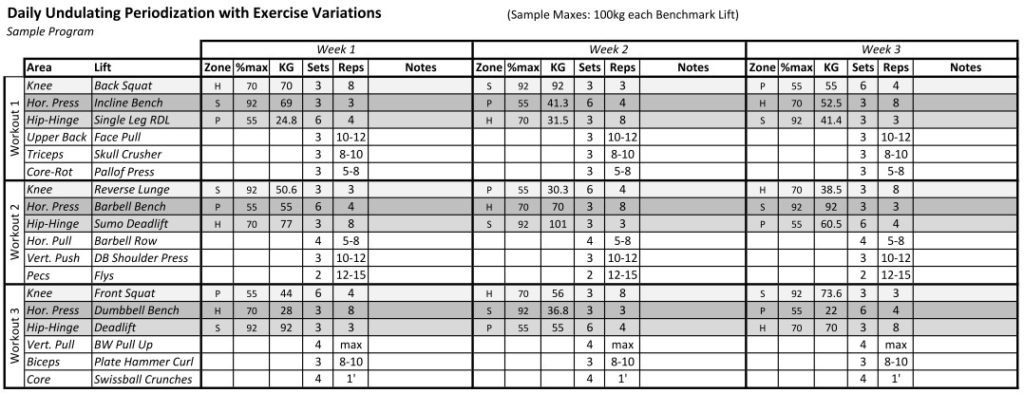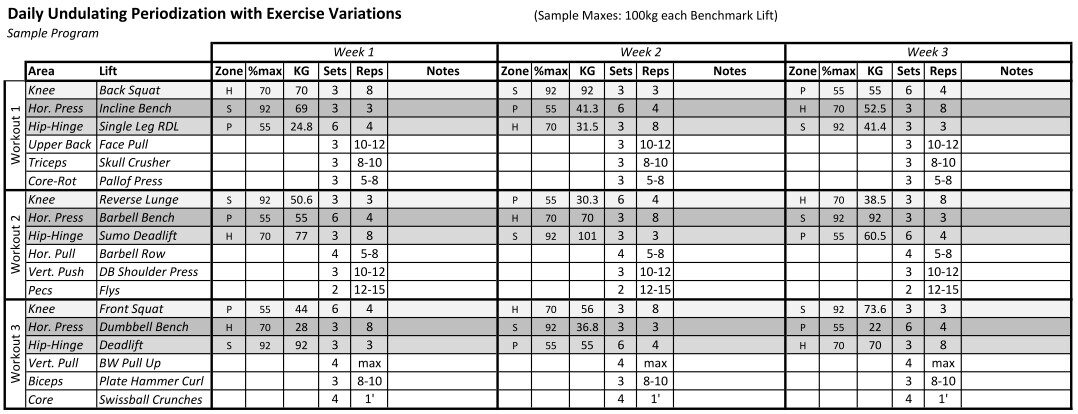Make your DUP even more interesting…
Because of lack of time I could train, I sacrificed the good old upper/lower-split for another concept for my strength training that I want to share with you: I call it the “Daily Undulating Periodization with Exercise Variation, short: DUPEV”. Firstly, by no means I claim to be the first one to follow that concept, but to this day I have not come across someone doing the exact same thing. So I take this opportunity to get out the first content on my blog. This is a first short overview of the idea; in future posts I want to write more detailed about the different components.
But for now let’s make an overview and decompose the DUPEV:
Whole-Body-Workouts: I started with the concept when I reduced from 4 to only 3 training days. With “only” three workouts in a week (one day on, one/two day off), a split would still be possible but there I generally prefer to work all the body parts every workout to maximize frequency. Because of time and energy reasons (reduction to the essentials) I prefer lifts that include different muscles and/or muscle groups at a time over isolation work. When talking about the essentials often we end up with the “Big 3”: The Deadlift (Hip-Hinge), Bench (Horizontal Pressing) and Squat (Knee-Dominant) are a great basis to build a workout around. They work a lot of muscle mass including the midsection and cover basic movement patterns. A plus is that they are often used to track progress in strength training and of course working these lifts satisfies my inner wannabe-powerlifter. In addition to the “Big 3”, there is a need for accessory lifts to work other areas of the body more specific (e.g. pulling exercises, prehab, work on individual weaknesses etc.)
Exercise Variations: The exercises I built the framework around are, as mentioned, Squat, Deadlift and Bench: As I’m not married to any of the exercises and I think diverse workouts build more balanced athletes, the concept uses exercise variations of the main lifts. This might be the biggest difference to the DUP for powerlifters where the focus is mainly on the competition lifts. But for general athleticism, I don’t see why one should only stick to the Big 3 when the world offers so many cool and rewarding exercises and variations. Long story short: Every of the 3 workout day has one variation of the Squat, the Deadlift and the Bench Press. The list of possible exercises you could use is long and depends also on what equipment is available at the place you work out. To keep it simple for the sample workout I use the following variations of the exercises where you only need basic equipment you should find in any gym:

As you can see, I kept the “Big 3” in as benchmark exercises: For these lifts you should know and test your 1RM prior to the DUPEV because you will use them for programming the weights and track/adjust the progress. On the same time, this means that you have to introduce correction factors to get from the Benchmark-Exercise-1RM to the Variation-Exercise-1RM. Some values can be found in literature while some can be found by try and error: For the sample work out I used the correction factors that are red in the table. Some might be slightly too hard or too easy depending on athlete and his/her abilities and can be adjusted individually, but with these values I think that you have a good start. Want an example?
If your Bench Press 1RM is 100kg your theoretical Dumbbell Bench Press 1RM would be 40kg on each side. Correcting the 1RM for the variations is a key in this program to be able to variate AND undulate at the same time.
Daily Undulation: Undulation in strength training means that over a given time you vary your training in volume and intensity to stress the body to different adaptions at the same time. Daily gives you the timeframe for this variation, that means in Daily Undulation you change intensity (normally %1RM) and volume (normally Sets& Reps) every training day.
Because the DUPEV framework has 3 Training days per week, it’s kind of straight forward to work in 3 different “strength-zones” for the undulation. The Set/Rep/% schemes depend on the main adaptation you want to achieve. To cover various interdependent basic qualities of strength I chose to work in the Hypertrophy (H), Absolute Strength (S) and Power (P) zone. Again: different combinations for Sets and Reps are possible for each zone: I plan to expand this section in future but for now, after some adjusting, I suggest the following working sets to start with:

Organization of the Main Lifts: Now let’s get to the core part; combining the daily undulation with the exercise variations. Firstly to the combination of the lifts in the workout: Every training day have one benchmark exercise, one unilateral exercise and one of the oher variations. For the “zones” we work one of the exercises per day in the Power, one in the Hypertrophy and one in the Strength zone. To work every exercise variation in every zone therefore we need 9 different Workouts. This adds up to 3 Weeks for a full cycle, if we work out 3 times a week. Sounds confusing? The combination of the main lifts looks like this:

To prescribe the weights for the different days we can use simple math: First you take the Benchmark 1RM and calculate the corrected 1RM for the Variation (BM_1RM*Correction_Factor=VAR_1RM) and after that you simply can use the corrected 1RM and the %1RM to calculate the weight for the working set. Let’s make the quick example for the knee-dominant unilateral exercise in Week 1:

Assistance Work: After having put together the main part of the program lets get to the assistance lifts. I like to limit the Workouts to 6-8 Exercises per day, three are already taken with the main lifts and their variations. The first three exercises in combination will already be hard to do or challenging to say the least and with the rest periods between sets/exercises they will take some time to perform. With the assistance lifts we have a chance to work on weaknesses and target other muscles/areas than the main lifts. The goal is still to have balanced workouts for the whole body. With 3×3 Exercises this gives 9 Areas we can work on over one week:

Putting the pieces together: Now you know about the main components of DUPEV, so last part is to combine all the pieces to put together a program that you can do in the weight room. I save you all unnecessary words and present you a sample program: All maxes are unrealistically set at 100kg, but it’s to show you how a finished program looks like:

What’s next: I presented you the main framework, means the basics… In a next article I want to present you how you can adjust and progress the DUPVE and of course I’m working on a easy to use Excel file for download: The actual version I use for myself grew with time and is a collection of workarounds, and that’s not what I like to share.
Stay tuned for more!

